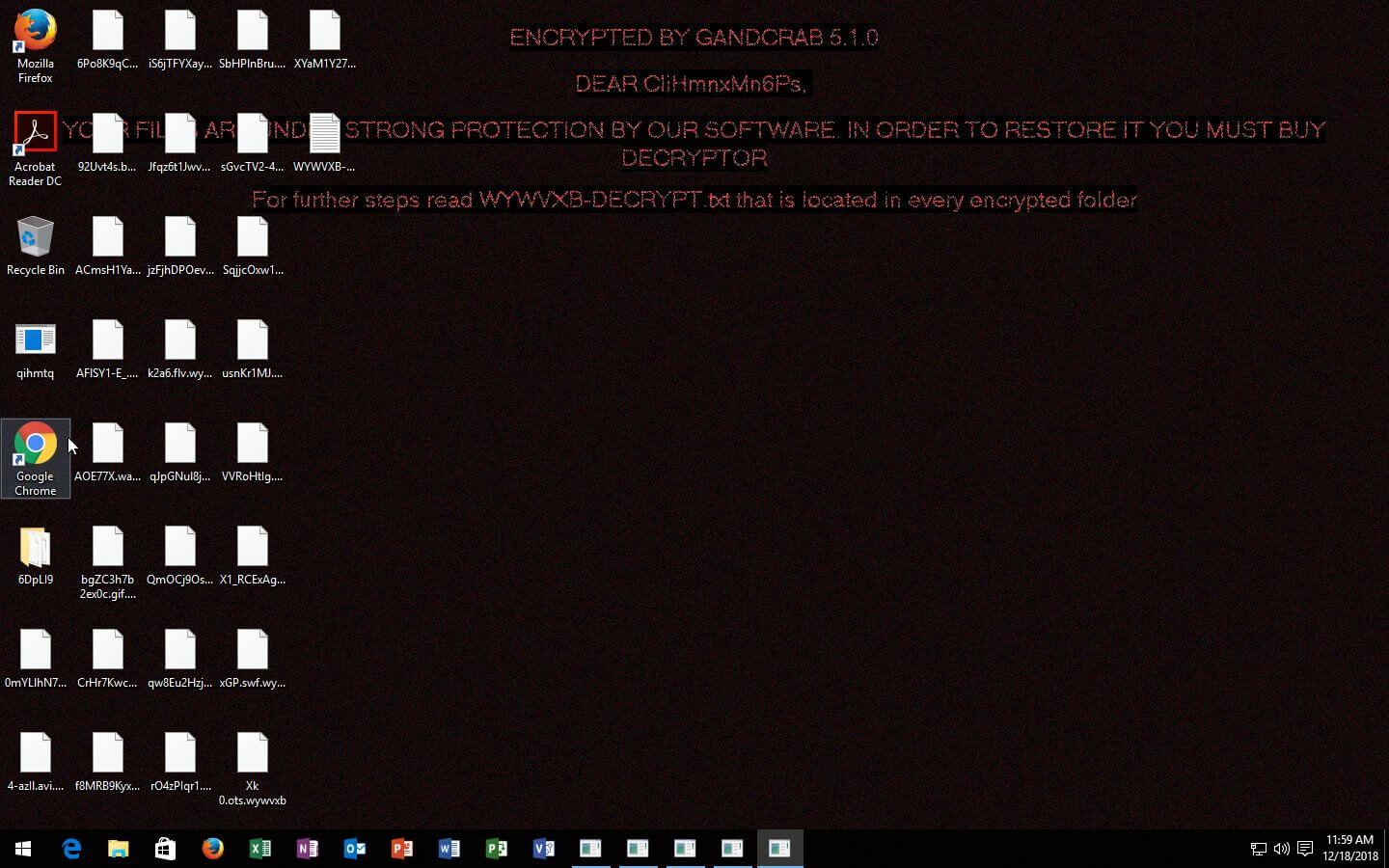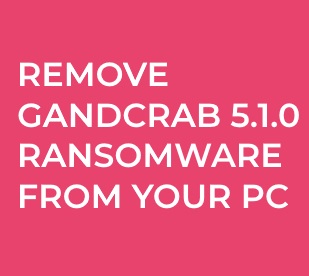 This article has been created in order to show what is GANDCRAB 5.1.0 ransomware and how to remove it from your PC and try to restore files, encrypted by it.
This article has been created in order to show what is GANDCRAB 5.1.0 ransomware and how to remove it from your PC and try to restore files, encrypted by it.
A new strain of the notorious GandCrab ransomware family, called GANDCRAB 5.1.0 has been released in the wild and infections with it have been reported. This strain follows the classic infection behavior by encrypting files on the target computers and coercing the victims into paying them a decryption fee. If your computer has been infected by this instance of GandCrab ransomware, we suggest that you read the following article as it explains more about GANDCRAB 5.1.0 and aims to show how to remove it and how you can attempt to recover encrypted files by yourself.

Threat Summary
| Name | GANDCRAB 5.1.0 |
| Type | Ransomware, Cryptovirus |
| Short Description | The GANDCRAB 5.1.0 ransomware is a variant of GandCrab family and encrypts files on your computer system and demands a ransom to be paid to decode them. |
| Symptoms | The ransomware will encrypt your files adding a random file extension and leave a ransom note with payment instructions. |
| Distribution Method | Spam Emails, Email Attachments |
| Detection Tool |
See If Your System Has Been Affected by malware
Download
Malware Removal Tool
|
User Experience | Join Our Forum to Discuss GANDCRAB 5.1.0. |
| Data Recovery Tool | Windows Data Recovery by Stellar Phoenix Notice! This product scans your drive sectors to recover lost files and it may not recover 100% of the encrypted files, but only few of them, depending on the situation and whether or not you have reformatted your drive. |

GandCrab Ransomware – Update February 2019

GANDCRAB 5.1.0 – Distribution Techniques
The GandCrab 5.1.0 ransomware sample is being distributed using the common methods attributed to the GandCrab family of malware. Most of the infections are caused through exploit kits that coordinate the attacks mainly through phishing email messages that impersonate legitimate notifications from web services or software companies. The users are coerced to interact with them in some way — to open a file, download a script or run a certain interactive element. The code that will lead to the Gandcrab 5.1.0 infection can be found in basically every element — pop-up, redirects, images and etc.
The criminals can additionally opt to create malicious web pages that may impersonate vendor download pages, portals or other sites that the users can access and infect themselves with the GandCrab ransomware samples. They will use stolen design elements, text and layout that can impersonate the real web sites. To further manipulate the victims similar sounding domain names and stolen security certificates.
Infected payload carriers may also be the cause of contaminated hosts, there are two popular types:
- Application Installers — The malware code can be embedded in the setup files of popular programs that are downloaded by end users: system utilities, creativity programs, productivity and office solutions and etc. Even simply running the file can lead to a successful GandCrab 5.1.0 infection.
- Infected Documents — The other method used to infect files targets documents of all popular types: spreadsheets, presentations, text files and databases. Whenever they are opened by the users a prompt will appear asking them to enable the built-in macros (scripts) in order to view the document or interact with its built-in fields. If this action is done the virus will be deployed to the target machines.
We have received confirmation that GandCrab ransomware is widely distributed across file-sharing networks and BitTorrent in particular. This peer-to-peer technology is widely used to share both legitimate content and also pirate software, cracks and games.
Infections with this threat can also be caused through the installation of malware plugins made for the most popular web browsers, alternatively known as browser hijackers. They are uploaded to the relevant repositories using fake developer credentials and user reviews in order to coerce the users into downloading and installing them. The descriptions will offer promises of new features or performance optimizations. Instead of this when installed they will change the settings of the browsers in order to redirect the users to a scam landing page. At the same time the ransomware threat will be deployed alongside it.

GANDCRAB 5.1.0 – Detailed Analysis
Like previous GandCrab versions the security analysis of the captured GandCrab 5.1.0 ransomware samples reveals a complex infection scheme.
When the virus is introduced on the victim machine the engine will deploy the threat as a persistent infection. This means that it will modify the operating system settings, boot options and important configuration files in order to automatically start itself every time the computer is started. This is very dangerous as it practically renders many manual user removal guides non-working, in this event the victims may need to use a quality anti-spyware solution to completely restore their systems.
Another function that is called by the engine is the security bypass which will search the operating system for security software or services that may be installed. Their real-time engines will be disabled in order to block detection of the malware. Some advanced samples may additionally delete themselves if they fail this step. It can also detect whether or not the instance is run inside a virtual machine or a debug environment. This is another dangerous tactic which makes security analysis very difficult.
When these steps have completed information harvesting will take place. The typical cases usually group the data in two main categories:
- Personal Information — This group of data can directly reveal personal information bout the computer user: their name, address, phone number, location and any stored account credentials. This is possible thanks to the possibility of the GandCrab 5.1.0 ransomware engine to search the local hard drive contents, memory and other sources of data.
- Machine Identification — Ransomware strains like this one assign an unique ID which is made based on input values that are collected by the engine. The required data is obtained from the list of installed hardware parts, user settings and operating system conditions.
When all of these components have finished running the virus will proceed with System modifications, particularly ones concerning the Windows Registry. Modifications made to strings belonging to the operating system can result in serious problems with the stability of the affected machines. Modifications to third-party applications can render them completely unusable.
What’s more dangerous is that the virus can connect to a hacker-controlled server via a Trojan horse client with the TOR Hidden service. This anonymous network connection will report of the made infection and make it possible for the malicious operators to steal user data before the encryption takes place, take over control of the machines and deploy other threats.

GANDCRAB 5.1.0 – Encryption Process
As soon as all prior modules have completed running the ransomware component will be started. A built-in list of target file type extensions will be used to choose which user data to process with the powerful cipher:
- Archives
- Databases
- Backups
- Music
- Videos
- Images
The resulting data will be renamed with a randomly generated 6-character extension. Users can recognize the infection by looking at their wallpaper which will be changed with the ransomware note. Additionally the text can be copied in files that are found in various folders on the local hard disk drive.

Remove GANDCRAB 5.1.0 Virus and Try Restoring Data
If you are a victim of GANDCRAB v5.1.0 ransomware, you should get rid of this ransomware as quickly as possible before it replicates on other devices and infects them. You should remove the ransomware virus, preferably by following the manual or automatic removal steps underneath. They have been made with the main goal to help you detect and delete the virus files of GandCrab either manually or automatically. For best results, it is highly advisable to download and run a scan with a reputable anti-malware program. Such software aims to detect and remove all GANDCRAB 5.1.0-related files and objects automatically and also aims to ensure future threat protection.
If you want to recover files, encrypted by this GANDCRAB 5.1.0 variant, we would advise you to follow the file recovery methods below. We have created them to help users to try and restore as many files as possible, although the methods come with no 100% guarantee to work.
- Step 1
- Step 2
- Step 3
- Step 4
- Step 5
Step 1: Scan for GANDCRAB 5.1.0 with SpyHunter Anti-Malware Tool



Ransomware Automatic Removal - Video Guide
Step 2: Uninstall GANDCRAB 5.1.0 and related malware from Windows
Here is a method in few easy steps that should be able to uninstall most programs. No matter if you are using Windows 10, 8, 7, Vista or XP, those steps will get the job done. Dragging the program or its folder to the recycle bin can be a very bad decision. If you do that, bits and pieces of the program are left behind, and that can lead to unstable work of your PC, errors with the file type associations and other unpleasant activities. The proper way to get a program off your computer is to Uninstall it. To do that:


 Follow the instructions above and you will successfully delete most unwanted and malicious programs.
Follow the instructions above and you will successfully delete most unwanted and malicious programs.
Step 3: Clean any registries, created by GANDCRAB 5.1.0 on your computer.
The usually targeted registries of Windows machines are the following:
- HKEY_LOCAL_MACHINE\Software\Microsoft\Windows\CurrentVersion\Run
- HKEY_CURRENT_USER\Software\Microsoft\Windows\CurrentVersion\Run
- HKEY_LOCAL_MACHINE\Software\Microsoft\Windows\CurrentVersion\RunOnce
- HKEY_CURRENT_USER\Software\Microsoft\Windows\CurrentVersion\RunOnce
You can access them by opening the Windows registry editor and deleting any values, created by GANDCRAB 5.1.0 there. This can happen by following the steps underneath:


 Tip: To find a virus-created value, you can right-click on it and click "Modify" to see which file it is set to run. If this is the virus file location, remove the value.
Tip: To find a virus-created value, you can right-click on it and click "Modify" to see which file it is set to run. If this is the virus file location, remove the value.
Before starting "Step 4", please boot back into Normal mode, in case you are currently in Safe Mode.
This will enable you to install and use SpyHunter 5 successfully.
Step 4: Boot Your PC In Safe Mode to isolate and remove GANDCRAB 5.1.0





Step 5: Try to Restore Files Encrypted by GANDCRAB 5.1.0.
Method 1: Use STOP Decrypter by Emsisoft.
Not all variants of this ransomware can be decrypted for free, but we have added the decryptor used by researchers that is often updated with the variants which become eventually decrypted. You can try and decrypt your files using the instructions below, but if they do not work, then unfortunately your variant of the ransomware virus is not decryptable.
Follow the instructions below to use the Emsisoft decrypter and decrypt your files for free. You can download the Emsisoft decryption tool linked here and then follow the steps provided below:
1 Right-click on the decrypter and click on Run as Administrator as shown below:

2. Agree with the license terms:
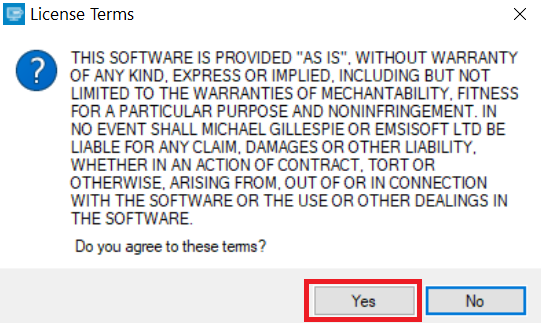
3. Click on "Add Folder" and then add the folders where you want files decrypted as shown underneath:
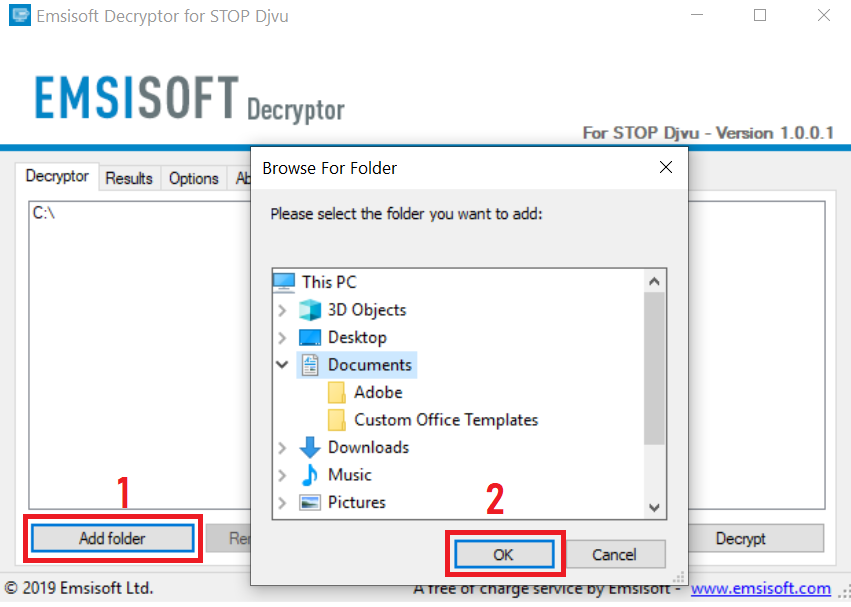
4. Click on "Decrypt" and wait for your files to be decoded.
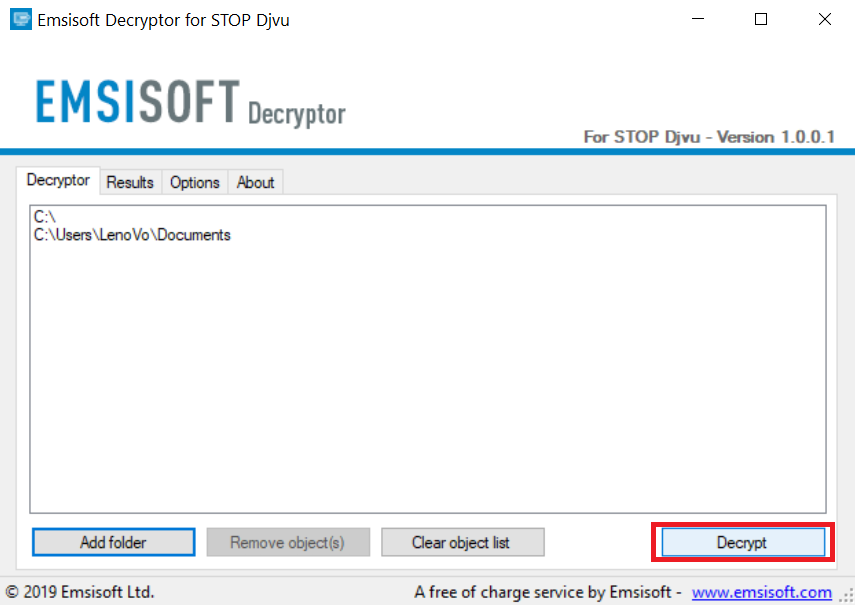
Note: Credit for the decryptor goes to Emsisoft researchers who have made the breakthrough with this virus.
Method 2: Use data recovery software
Ransomware infections and GANDCRAB 5.1.0 aim to encrypt your files using an encryption algorithm which may be very difficult to decrypt. This is why we have suggested a data recovery method that may help you go around direct decryption and try to restore your files. Bear in mind that this method may not be 100% effective but may also help you a little or a lot in different situations.
Simply click on the link and on the website menus on the top, choose Data Recovery - Data Recovery Wizard for Windows or Mac (depending on your OS), and then download and run the tool.
GANDCRAB 5.1.0-FAQ
What is GANDCRAB 5.1.0 Ransomware?
GANDCRAB 5.1.0 is a ransomware infection - the malicious software that enters your computer silently and blocks either access to the computer itself or encrypt your files.
Many ransomware viruses use sophisticated encryption algorithms to make your files inaccessible. The goal of ransomware infections is to demand that you pay a ransom payment to get access to your files back.
What Does GANDCRAB 5.1.0 Ransomware Do?
Ransomware in general is a malicious software that is designed to block access to your computer or files until a ransom is paid.
Ransomware viruses can also damage your system, corrupt data and delete files, resulting in the permanent loss of important files.
How Does GANDCRAB 5.1.0 Infect?
Via several ways.GANDCRAB 5.1.0 Ransomware infects computers by being sent via phishing emails, containing virus attachment. This attachment is usually masked as an important document, like an invoice, bank document or even a plane ticket and it looks very convincing to users.
Another way you may become a victim of GANDCRAB 5.1.0 is if you download a fake installer, crack or patch from a low reputation website or if you click on a virus link. Many users report getting a ransomware infection by downloading torrents.
How to Open .GANDCRAB 5.1.0 files?
You can't without a decryptor. At this point, the .GANDCRAB 5.1.0 files are encrypted. You can only open them once they are decrypted using a specific decryption key for the particular algorithm.
What to Do If a Decryptor Does Not Work?
Do not panic, and backup the files. If a decryptor did not decrypt your .GANDCRAB 5.1.0 files successfully, then do not despair, because this virus is still new.
Can I Restore ".GANDCRAB 5.1.0" Files?
Yes, sometimes files can be restored. We have suggested several file recovery methods that could work if you want to restore .GANDCRAB 5.1.0 files.
These methods are in no way 100% guaranteed that you will be able to get your files back. But if you have a backup, your chances of success are much greater.
How To Get Rid of GANDCRAB 5.1.0 Virus?
The safest way and the most efficient one for the removal of this ransomware infection is the use a professional anti-malware program.
It will scan for and locate GANDCRAB 5.1.0 ransomware and then remove it without causing any additional harm to your important .GANDCRAB 5.1.0 files.
Can I Report Ransomware to Authorities?
In case your computer got infected with a ransomware infection, you can report it to the local Police departments. It can help authorities worldwide track and determine the perpetrators behind the virus that has infected your computer.
Below, we have prepared a list with government websites, where you can file a report in case you are a victim of a cybercrime:
Cyber-security authorities, responsible for handling ransomware attack reports in different regions all over the world:
Germany - Offizielles Portal der deutschen Polizei
United States - IC3 Internet Crime Complaint Centre
United Kingdom - Action Fraud Police
France - Ministère de l'Intérieur
Italy - Polizia Di Stato
Spain - Policía Nacional
Netherlands - Politie
Poland - Policja
Portugal - Polícia Judiciária
Greece - Cyber Crime Unit (Hellenic Police)
India - Mumbai Police - CyberCrime Investigation Cell
Australia - Australian High Tech Crime Center
Reports may be responded to in different timeframes, depending on your local authorities.
Can You Stop Ransomware from Encrypting Your Files?
Yes, you can prevent ransomware. The best way to do this is to ensure your computer system is updated with the latest security patches, use a reputable anti-malware program and firewall, backup your important files frequently, and avoid clicking on malicious links or downloading unknown files.
Can GANDCRAB 5.1.0 Ransomware Steal Your Data?
Yes, in most cases ransomware will steal your information. It is a form of malware that steals data from a user's computer, encrypts it, and then demands a ransom in order to decrypt it.
In many cases, the malware authors or attackers will threaten to delete the data or publish it online unless the ransom is paid.
Can Ransomware Infect WiFi?
Yes, ransomware can infect WiFi networks, as malicious actors can use it to gain control of the network, steal confidential data, and lock out users. If a ransomware attack is successful, it could lead to a loss of service and/or data, and in some cases, financial losses.
Should I Pay Ransomware?
No, you should not pay ransomware extortionists. Paying them only encourages criminals and does not guarantee that the files or data will be restored. The better approach is to have a secure backup of important data and be vigilant about security in the first place.
What Happens If I Don't Pay Ransom?
If you don't pay the ransom, the hackers may still have access to your computer, data, or files and may continue to threaten to expose or delete them, or even use them to commit cybercrimes. In some cases, they may even continue to demand additional ransom payments.
Can a Ransomware Attack Be Detected?
Yes, ransomware can be detected. Anti-malware software and other advanced security tools can detect ransomware and alert the user when it is present on a machine.
It is important to stay up-to-date on the latest security measures and to keep security software updated to ensure ransomware can be detected and prevented.
Do Ransomware Criminals Get Caught?
Yes, ransomware criminals do get caught. Law enforcement agencies, such as the FBI, Interpol and others have been successful in tracking down and prosecuting ransomware criminals in the US and other countries. As ransomware threats continue to increase, so does the enforcement activity.
About the GANDCRAB 5.1.0 Research
The content we publish on SensorsTechForum.com, this GANDCRAB 5.1.0 how-to removal guide included, is the outcome of extensive research, hard work and our team’s devotion to help you remove the specific malware and restore your encrypted files.
How did we conduct the research on this ransomware?
Our research is based on an independent investigation. We are in contact with independent security researchers, and as such, we receive daily updates on the latest malware and ransomware definitions.
Furthermore, the research behind the GANDCRAB 5.1.0 ransomware threat is backed with VirusTotal and the NoMoreRansom project.
To better understand the ransomware threat, please refer to the following articles which provide knowledgeable details.
As a site that has been dedicated to providing free removal instructions for ransomware and malware since 2014, SensorsTechForum’s recommendation is to only pay attention to trustworthy sources.
How to recognize trustworthy sources:
- Always check "About Us" web page.
- Profile of the content creator.
- Make sure that real people are behind the site and not fake names and profiles.
- Verify Facebook, LinkedIn and Twitter personal profiles.


